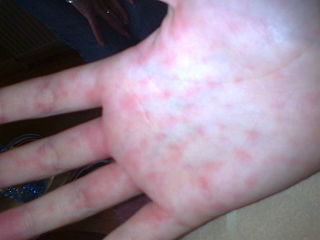
 SCHAUMBURG, IL — To the untrained eye, all rashes may look alike and seem easily treatable with over-the-counter oral antihistamines or hydrocortisone cream. However, it is not so simple, say member dermatologists from the American Academy of Dermatology. Rashes can appear as blotches, welts or blisters; they can be red, itchy, scaly, or dry; and they can occur in one area of skin or all over the body. In addition, say dermatologists, some rashes may come and go, while others never seem to go away.
SCHAUMBURG, IL — To the untrained eye, all rashes may look alike and seem easily treatable with over-the-counter oral antihistamines or hydrocortisone cream. However, it is not so simple, say member dermatologists from the American Academy of Dermatology. Rashes can appear as blotches, welts or blisters; they can be red, itchy, scaly, or dry; and they can occur in one area of skin or all over the body. In addition, say dermatologists, some rashes may come and go, while others never seem to go away.“Most rashes are not life-threatening, but some can signal something more serious,” said board-certified dermatologist Daniela Kroshinsky, MD, MPH, FAAD, associate professor of dermatology, Harvard Medical School. “Since rashes can have many causes, if you have concerns, the best way to correctly diagnose a rash is to see a doctor for evaluation.”
If you have a rash and notice any of the following symptoms, Dr. Kroshinsky recommends seeing a board-certified dermatologist or going to the emergency room:
1. The rash is all over your body: A rash that covers the body could indicate something concerning, such as an infection or allergic reaction.
2. You have a fever with the rash: If this is the case, see your doctor or go to the emergency room. This could be caused by an allergic reaction or an infection. Examples of rashes caused by infection include scarlet fever, measles, mononucleosis, and shingles.
3. The rash is sudden and spreads rapidly: This could be the result of an allergy. Allergies to medications are common, and some can be dangerous. If breathing becomes difficult, go to the emergency room or call 911.
4. The rash begins to blister: If your rash is made up of blisters, or if the rash turns into open sores, it could be the result of an allergic reaction, a reaction to medication, or an internal cause. Seek medical attention if a blistering rash affects the skin around your eyes, multiple areas in your mouth or your genitals.
5. The rash is painful: Painful rashes should quickly be evaluated by a physician.
6. The rash is infected: If you have an itchy rash and you scratch it, it may become infected. Signs of an infected rash are yellow or green fluid, swelling, crusting, pain and warmth in the area of the rash, or a red streak coming from the rash.
“Rashes can come in many forms and, depending on the cause, take days or even weeks to heal,” said Dr. Kroshinsky. “Rather than treating the rash on your own, see a board-certified dermatologist for the proper diagnosis and treatment.”
These tips are demonstrated in “Rash 101 in Adults: When to Seek Treatment,” a video posted to the Academy website and the Academy’s YouTube channel. This video is part of the Dermatology A to Z: Video Series, which offers videos demonstrating tips people can use to properly care for their skin, hair and nails. A new video in the series posts to the Academy’s website and YouTube channel each month.
Headquartered in Schaumburg, Ill., the American Academy of Dermatology, founded in 1938, is the largest, most influential, and most representative of all dermatologic associations. With a membership of more than 18,000 physicians worldwide, the Academy is committed to: advancing the diagnosis and medical, surgical and cosmetic treatment of the skin, hair and nails; advocating high standards in clinical practice, education, and research in dermatology; and supporting and enhancing patient care for a lifetime of healthier skin, hair and nails. For more information, contact the Academy at 1-888-462-DERM (3376) or www.aad.org. Follow the Academy on Facebook ( American Academy of Dermatology), Twitter (@AADskin), or YouTube (AcademyofDermatology).
To view a media-rich version of this release, go to: http://www.pwrnewmedia.com/2015/aad/rash/
Jennifer Allyn (847) 240-1730 Email Contact Nicole DiVito (847) 240-1746 Email Contact Amanda Jacobs (847) 240-1714 Email Contact
Source: American Academy of Dermatology

